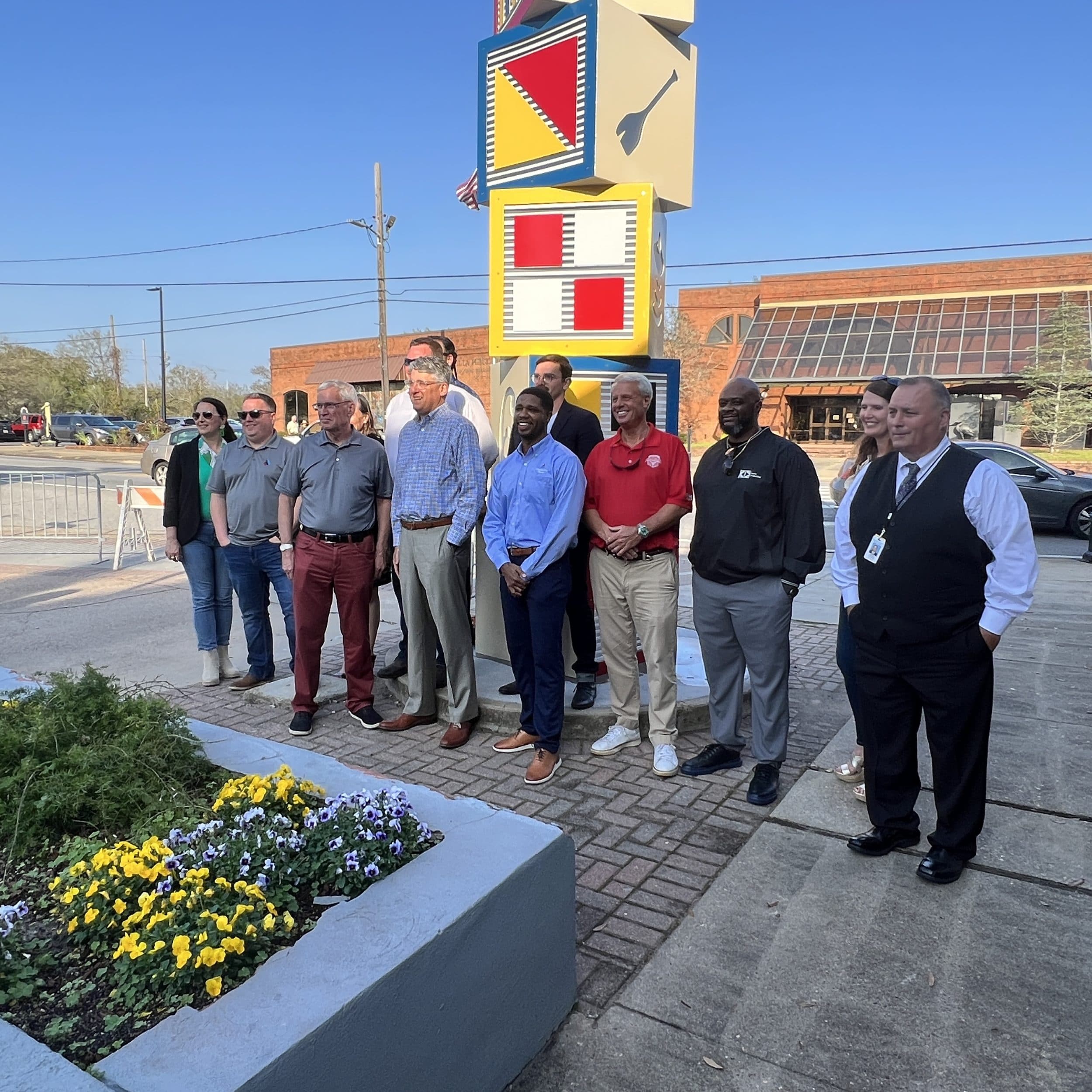An eye-catching sculpture now stands on the south side of the entrance to the Downtown Plaza in Pascagoula.
Located at Delmas Avenue and Pascagoula Street, the sculpture, named “Building Blocks,” is the first of three sculptures to be placed around the city as a strategic part of the city’s downtown revitalization effort.
Standing 15 feet high on top of a pedestal and made up of five 3 foot x 3 foot blocks stacked on top of each other, the sculpture depicts various facets of Pascagoula.
Each of the blocks, which are replicas of the building block toys that almost every person has played with as a child, has a letter on one side, a number on another side, and a picture on another. So there is a 3-9-5-6-7 for the city zip code and G-O-U-L-A for the city nickname. There are also pictures of a gull, an oar, a UFO, a lighthouse, and an anchor among the five blocks. And, because Pascagoula is the flagship city, there’s the shipyard and there are Navy flags on yet another side of the blocks.
“It [the sculpture] helps lift pride and lift enthusiasm and provides a sense of belonging. And when you see it, you know this is Pascagoula. It’s not us trying to be some other community. This is us celebrating who we’ve been, who we are, and who we will be,” said Paige Roberts, President and CEO of the Jackson County Chamber of Commerce.
The theme for the piece of artwork came from feedback from various residents of Pascagoula, in how they see the city, and what they think of when they think of the city. And what residents think about Pascagoula is that we build things here, and we also build community.
And that is what is depicted in each of the blocks – Pascagoula.
Roberts feels that this type of project is needed and is replicable among other communities.
“I think Mississippi has been known for its music, its writers, and its artists. This is just one more way to combine community development with economic development and really touch back to the roots of who we are, the generations that have come before us and the generations to come.”
Julian Rankin, Executive Director of the Walter Anderson Museum of Art (WAMA), shares that sentiment.
“Other districts and communities can look at us and see what we’ve done here and look at it as model. I think this is a test case for what’s possible in a county like Jackson County, but also what other communities can do that’s tailored to their place. That’s the really important thing, that while this is a place-specific project, it can happen in any community as long as it’s true to their identity.”
The idea for the sculpture began with the Chamber of Commerce wanting to bring economic development to downtown Pascagoula. Since art is a big player in community and economic development, the idea was to bring public art together with economic development, and WAMA was the perfect partner for that project.
Naturally, the ideal location for such a sculpture is downtown Pascagoula where so much activity and opportunities on that front are happening in the form of retail, restaurants, and residences.
“It’s a very exciting time in downtown Pascagoula,” Roberts said.
The project would also create work force development with the College and Career Technical Institute of the Pascagoula-Gautier School District (PGSD). Once the Chamber and WAMA knew what they wanted to do, they reached out to Derek Read, CTE Director of the PGSD, informing him they wanted to do a project with his welding students.
Read was on board for that and for them to get recognition for doing it, but he was concerned about whether his students could take on such a project. He thought he would have to step in and make them do it. But he didn’t have to.
“They never hesitated. They were on board from day one. I never had to make them do anything. They were like, ‘Yes, absolutely!’”
Knowing that the project would give his students some applied skills and opportunities to make something not just in the classroom, but to go out and leave their mark on the community, he considered it a “no-brainer” to get involved.
“This is something I can bring my grandkids to and they can bring their grandkids to and show them we had a little part in this,” Read said.
Rankin is overwhelmed by the end result of the students’ work.
“They welded, machined, and painted. It’s really been an amazing accomplishment.”
The project was a collaborative effort among numerous people, and for other communities who want to do anything local and meaningful, Rankin’s message to them is to “just work together.”




